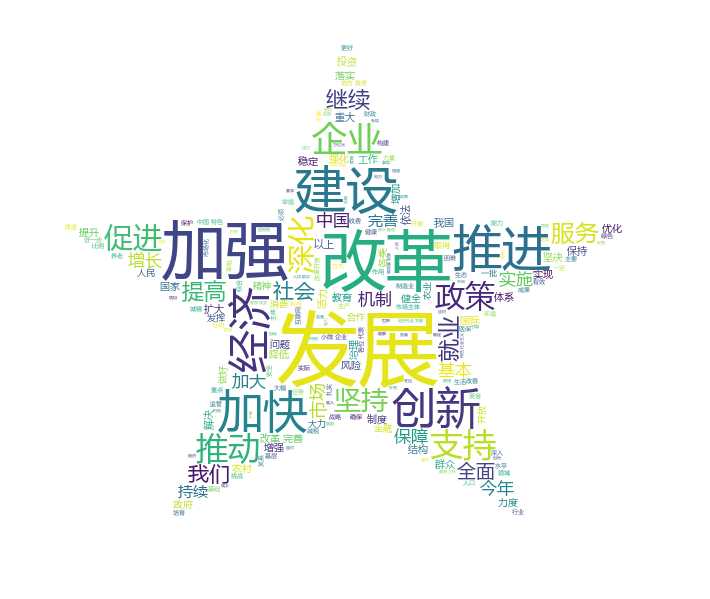标签:tin ima lse 图片 width 并且 像素 sort ever
import wordcloud
import jieba
from imageio import imread
mask = imread("五角星.png")
f = open("2019政府工作报告.txt","r",encoding="utf-8")
t = f.read()
f.close()
ls = jieba.lcut(t)
txt = " ".join(ls)
w = wordcloud.WordCloud(font_path = "msyh.ttc",width = 1000, height = 700,background_color = "white", mask = mask )
#生成词云:字体微软雅黑,宽1000,高度700,背景白色
w.generate(txt)
w.to_file("grwordcloud.png")
import wordcloud
def getText():
"""打开文件,将文件内容变为字符串,并且全部转换为英文小写,同时将文本中的特殊字符替换为空格"""
txt = open("Hamlet.txt", "r", encoding='UTF-8').read()
txt = txt.lower()
for ch in '!"#$%&()*+,-./:;<=>?@[\\]^_‘’{|}~':
txt = txt.replace(ch, " ")
return txt
#排除常用词(随便改)
excludes = {
"ll",
"him",
"your",
"but",
"the",
"we",
"o",
"by",
"do",
"are",
"and",
"no",
"s",
"d",
"this",
"my",
"or",
"if",
"our",
"shall",
"from",
"come",
"come",
"thou",
"let",
"there",
"t",
"how",
"now",
"thy",
"may",
"most",
"more",
"to",
"he",
"a",
"of",
"was",
"it",
"you",
"she",
"in",
"that",
"said",
"her",
"i",
"his",
"they",
"had",
"as",
"for",
"with",
"so",
"not",
"then",
"when",
"on",
"at",
"all",
"will",
"be",
"have",
"is",
"into",
"out",
"came",
"me",
"went",
"what",
"like",
"know",
"would",
"them",
"well"
}
hamTxet = getText()
words = hamTxet.split()
counts = {}
clouds = []
# 统计单词数,首先排除常用词,如果word在counts中,则返回word对应的值,如果word不在counts中,则返回0
for word in words:
if word in excludes:
continue
else:
counts[word] = counts.get(word, 0) + 1
# 将字典转化为列表
items = list(counts.items())
#根据单词出现的次数进行排序(倒序) --- 根据第二列排序,即单词的次数,而不是单词的名字
items.sort(key=lambda x:x[1], reverse=True)
#输出词汇出现频率的前十的词汇
for i in range(15):
word, count = items[i]
clouds.append(word)
print("{0:<10}{1:>10}".format(word, count))
#生成词云,宽度为1000像素,高度为700像素,使用微软雅黑, 背景白色, 最多出现15个单词
w = wordcloud.WordCloud(width=1000, font_path="msyh.ttc", height=700, background_color = "white", max_words = 15)
w.generate(hamTxet)
w.to_file("hamwcloud.png")标签:tin ima lse 图片 width 并且 像素 sort ever
原文地址:https://www.cnblogs.com/newbase/p/12077589.html